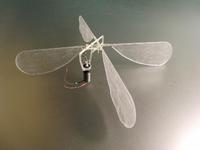 Researchers at the Cornell Computational Synthesis Laboratory building a miniature ornithopter (that’s a flying device that uses flapping wing motions for lift) had a problem: the wings were difficult to create due to their small size and mechanical requirements.
Researchers at the Cornell Computational Synthesis Laboratory building a miniature ornithopter (that’s a flying device that uses flapping wing motions for lift) had a problem: the wings were difficult to create due to their small size and mechanical requirements. The problem was solved by using 3D printing techniques to create the wings. The 3D printing approach also was substantially faster than previous methods: “reduced the time of a wing design cycle to a matter of minutes”.
According to their paper’s abstract:
An ornithopter with a mass of 3.89g has been constructed using the 3D printing technique and has demonstrated an 85-second passively stable untethered hovering flight. This flight exhibits the functional utility of printed materials for flapping wing experimentation and ornithopter construction and for understanding the mechanical principles underlying insect flight and control.
Via Cornell

